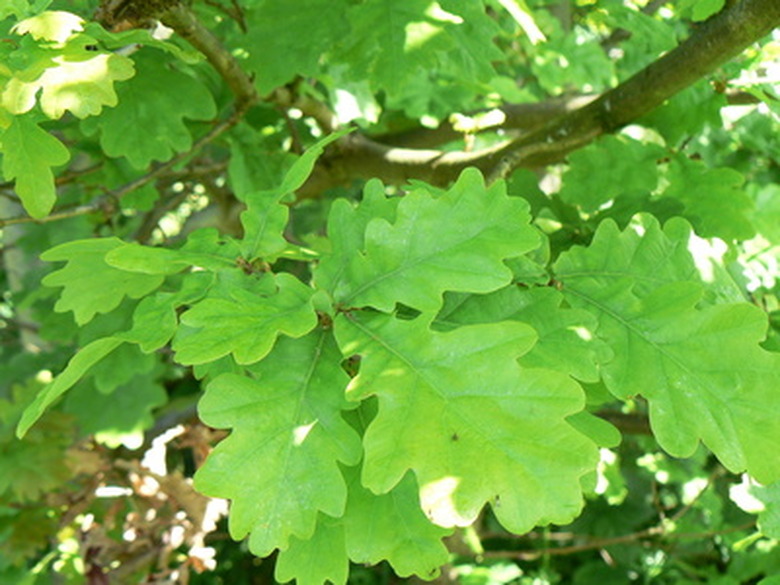Oak Trees Of Texas
Oak trees are one of the most common trees in the United States. The National Arbor Day Foundation numbers 60 species of oak as native to the United States. In 2004, the oak was officially recognized by Congress as America's National Tree. Texas is home to number of different species of oak, from giant shade trees to smaller shrubs.
Live Oak
The great spreading branches of live oak (Quercus virginiana) were once prized for shipbuilding. The trees have small, pinnate leaves and deeply grooved dark gray bark. Live oaks produce dark brown acorns approximately 1 inch long. The wood of live oak is very strong and rot resistant, and the massive limbs sometimes reach the ground. The trees are favorites in landscaping, remaining evergreen year round. Live oaks thrive in a variety of soils and tolerate drought well. They grow into the southern parts of Zone 7.
- Oak trees are one of the most common trees in the United States.
- The wood of live oak is very strong and rot resistant, and the massive limbs sometimes reach the ground.
Post Oak
Post oak (Quercus stellata) was the source of fence posts when many areas of Texas were first fenced. Post oaks can range in size to mere shrubs to 75 feet tall, according to Texas A&M University. The leaves of post oak are deeply lobed, and the bark resembles gray scales. Post oak trees produce inch-long, reddish-brown acorns. They are hardy to Zone 5.
Red Oak
The leaves of Texas red oak (Quercus texana) turns vivid red and orange in the fall. The trees grow primarily in North Central to Central Texas in limestone soils. The leaves are oblong and deeply lobed. The bark may be smooth and light gray or rough and a darker gray. The acorns are round, from 1/2 to 1 inch long and a dark red-brown. Red oaks don't tolerate cold well and grow only into Zone 8.
- Post oak (Quercus stellata) was the source of fence posts when many areas of Texas were first fenced.
- The leaves of post oak are deeply lobed, and the bark resembles gray scales.
Bur Oak
Bur oaks (Quercus macrocarpa) have long taproots, which make them very drought tolerant. These fast-growing, large trees are a favorite with landscapers throughout Texas. Bur oak leaves can be up to a foot long, according to Texas A&M University. The bark of the bur oak tree is thick, dark brown and deeply grooved. The trees produce large acorns up to 2 inches long, with attractive fringed caps. Bur oaks are hardy to Zone 3.
Gambel Oak
Gambel oaks (Quercus gambelii) grow above 6,000 feet in dense thickets in the mountains of West Texas. Trees may grow as tall as 25 feet. The dark green leaves are deeply lobed and fuzzy on the underside, and the bark is light gray and usually smooth. The acorns are small, about 1/2 inch in diameter and dark brown. The trees are hardy to Zone 5 but never grow at low elevations.
- Bur oaks (Quercus macrocarpa) have long taproots, which make them very drought tolerant.
- Gambel oaks (Quercus gambelii) grow above 6,000 feet in dense thickets in the mountains of West Texas.
White Oak
White oaks (Quercus alba) grow in the piney woods of East Texas. White oaks can grow up to 100 feet tall and produce lots of 1/2- to 3/4-inch long, dark brown acorns, which are an important food source for wildlife. The light green, lobed leaves turn an attractive red in fall. The bark of live oaks is light gray to silver and flakes easily. These trees will grow to Zone 4, though they require acid soil.
